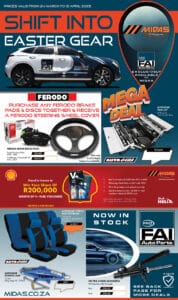This article will help you to identify early warning signs of shock and strut failure This will assist you in diagnostic issues before they become large problems.
Don’t forget Randburg Midas will be able to assist you will all your suspension needs! Contact us today (011) 789-4411 | marco@midasrandburg.co.za | 191 Bram Fischer Drive, Randburg.
Shock and Strut Warning Signs
Shocks and struts do not need to be replaced at specific mileage intervals so understanding how to identify the warning signs associated with failing shocks and struts is integral to your safety and the safety of your passengers. Shocks and struts wear out over time and the implications of failure could be dangerous. New shocks and struts can make you stop up to 10 feet sooner, while providing increased vehicle stability and better driver control.
Shock and Strut Warning Signs:
Excessive Bouncing
Coil springs are part of your vehicle’s suspension system. If your vehicle is designed with shocks, the coil springs are mounted between the wheels and the frame of the vehicle. Struts, on the other hand, are essentially a coil spring and shock absorber all in one piece. When you drive over a bump, your car bounces on the coil springs, regardless of whether you have shocks or struts. The shock absorbers in both cases keep your car from bouncing nonstop. So if you drive over a bump or a patch of rough road and your vehicle continues to bounce, it is an indication that you require a shock or strut replacement.
Nose Dives/Rear End Squats Dipping
Your car should be steady and stable at all times – whether you are braking, accelerating, or turning – so that you can maintain control as you drive. Shock and struts help keep the car steady.
When braking, if the front end of your vehicle, otherwise known as the nose, of your car dives, it is an indication that your shocks and struts need to be replaced, or at least evaluated. Another sign that your shocks or struts require service is if the rear end of your vehicle “squats” when you accelerate. Additionally, if you make a turn and the vehicle dips drastically to one side, your shocks or struts may need to be replaced.
Tire “Cupping” also known as Bald Spots
If the struts or shocks on your vehicle are bad, the tires will literally bounce up and down as you drive. Each time the tires hit the ground, bits of rubber can get scraped off. This is commonly referred to as “cupping” or “scalloping.” So instead of having a consistent treadwear pattern across the tire, you might have some tread, a smooth patch, some tread, a smooth patch, and so on. This is because the holes left by the missing rubber tend to get smoothed over as you drive.
Leaking Fluid
Inside every shock and strut is a piston and hydraulic fluid. When you drive over a bump or a rough stretch of road, the shocks or struts compress, causing the piston to push against the hydraulic fluid, which absorbs the force of the piston. Sometimes that fluid that can leak out of the shock or strut. Believe it or not, a little leakage is perfectly normal and will look like a small wet spot on an otherwise dry shock or strut. Leakage that you need to worry about will make most of the shock or strut look wet and oily.
Connect with us and share your photos of your goodies from Randburg Midas and tag #RandburgMidas
Facebook | Twitter | Youtube | Google+ | Instagram | LinkedIn | Pinterest
Source: https://www.pepboys.com/car_care_corner/car_care_basics/maintenance/shock_strut_warning_signs/





